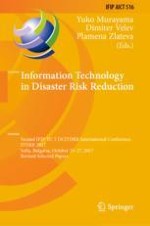2019 | Buch
Information Technology in Disaster Risk Reduction
Second IFIP TC 5 DCITDRR International Conference, ITDRR 2017, Sofia, Bulgaria, October 25-27, 2017, Revised Selected Papers
herausgegeben von: Yuko Murayama, Dimiter Velev, Plamena Zlateva
Verlag: Springer International Publishing
Buchreihe : IFIP Advances in Information and Communication Technology
